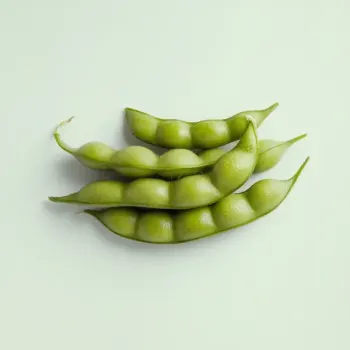Peas and edamame are both green legumes used in cooking, with peas being sweet and starchy and edamame offering a nuttier flavor and firmer texture. They can be substituted in dishes like salads and rice, with differences in taste and nutrition.

Peas are small, spherical seeds or the seed-pods of the Pisum sativum. Each pod contains several peas which can be green or yellow. Commonly known as garden peas, they are part of the legume family and have been cultivated for thousands of years. Peas are versatile and can be eaten raw or cooked, adding a sweet and slightly starchy flavor to dishes.

Edamame are young soybeans, usually still in the pod. Found in East Asian cuisines, they are harvested before they have ripened or hardened. Typically served steamed or boiled with a pinch of salt, edamame has a slightly grassy, nutty flavor and is rich in protein, making it a popular snack as well as a culinary ingredient.
While both peas and edamame are green legumes, they differ in taste, texture, and nutritional profile. Peas are sweet with a starchy texture, whereas edamame has a more pronounced nutty flavor and firmer bite. Peas are typically used in their shelled form, whereas edamame can be enjoyed in the pod. Nutritionally, edamame is higher in protein and contains different vitamins and minerals compared to peas.

Your ultimate Recipe Box, Meal Planner, and Cooking Class all in one
Peas can add a sweet flavor and soft texture to salads. They work well in both warm and cold salad recipes, such as pea and mint salad, or a mixed green salad with peas. Edamame provides a protein boost and a satisfying crunch in salads. They are ideal for Asian-inspired salad recipes or a hearty grain salad, adding both color and nutrition.
In soups and stews, peas can be used to add a natural sweetness and creaminess, especially when blended. Split pea soup is a classic example where peas are the star ingredient. Edamame can be added to soups or stews for a protein-rich element. They hold their shape and texture well in cooking, making them a great addition to chunky vegetable soups or Asian-inspired broths.
Peas are a common ingredient in rice dishes, adding a pop of color and a gentle sweetness. They are perfect in dishes like pea risotto or pilaf. Edamame can be included in rice dishes for added texture and a protein boost. They pair well with sushi rice or can be mixed into a fried rice dish for a unique twist.
Peas can be a delightful addition to pasta dishes, bringing a light sweetness that complements creamy sauces or the fresh flavors of spring vegetable pasta. Edamame can be used in pasta dishes as a succulent, protein-rich ingredient. They work especially well in Asian-style noodle dishes or as an addition to a cold pasta salad.
Both peas and edamame are good sources of fiber and protein, making them beneficial for a plant-based diet.
| Nutrient | Peas ( per 100 grams ) | Edamame ( per 100 grams ) |
|---|---|---|
| Fat | 0.4g | 5g |
| Fiber | 5.1g | 5g |
| Protein | 5.4g | 11g |
| Calories | 81 | 121 |
| Vitamin C | 40mg | |
| Carbohydrates | 14.5g | 9g |
While not traditional, peas can be used in sushi rolls for a sweet contrast, but they won't provide the same texture or protein content as edamame.
Both are nutritious, but edamame is higher in protein and healthy fats, while peas offer more vitamins and carbohydrates. The choice depends on your dietary needs and culinary preference.
Edamame should be cooked before consumption to ensure they are safe to eat, unlike peas which can be eaten raw if they are tender and young.
To prepare edamame for salads, boil or steam the pods in salted water, then cool them and remove the beans from the pods.
Yes, frozen peas tend to retain their sweetness, while frozen edamame maintains its nutty flavor. Both can lose a bit of texture once frozen and then thawed.